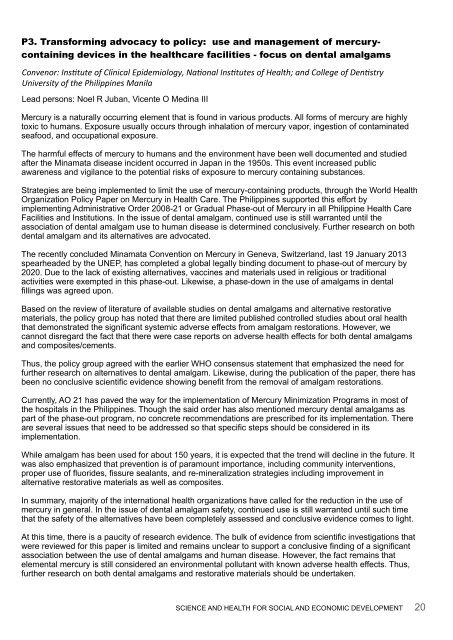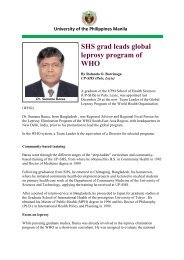NIH 2013 Program - University of the Philippines Manila
NIH 2013 Program - University of the Philippines Manila
NIH 2013 Program - University of the Philippines Manila
You also want an ePaper? Increase the reach of your titles
YUMPU automatically turns print PDFs into web optimized ePapers that Google loves.
P3. Transforming advocacy to policy: use and management <strong>of</strong> mercurycontaining<br />
devices in <strong>the</strong> healthcare facilities - focus on dental amalgams<br />
Convenor: Ins4tute <strong>of</strong> Clinical Epidemiology, Na4onal Ins4tutes <strong>of</strong> Health; and College <strong>of</strong> Den4stry<br />
<strong>University</strong> <strong>of</strong> <strong>the</strong> <strong>Philippines</strong> <strong>Manila</strong><br />
Lead persons: Noel R Juban, Vicente O Medina III<br />
Mercury is a naturally occurring element that is found in various products. All forms <strong>of</strong> mercury are highly<br />
toxic to humans. Exposure usually occurs through inhalation <strong>of</strong> mercury vapor, ingestion <strong>of</strong> contaminated<br />
seafood, and occupational exposure.<br />
The harmful effects <strong>of</strong> mercury to humans and <strong>the</strong> environment have been well documented and studied<br />
after <strong>the</strong> Minamata disease incident occurred in Japan in <strong>the</strong> 1950s. This event increased public<br />
awareness and vigilance to <strong>the</strong> potential risks <strong>of</strong> exposure to mercury containing substances.<br />
Strategies are being implemented to limit <strong>the</strong> use <strong>of</strong> mercury-containing products, through <strong>the</strong> World Health<br />
Organization Policy Paper on Mercury in Health Care. The <strong>Philippines</strong> supported this effort by<br />
implementing Administrative Order 2008-21 or Gradual Phase-out <strong>of</strong> Mercury in all Philippine Health Care<br />
Facilities and Institutions. In <strong>the</strong> issue <strong>of</strong> dental amalgam, continued use is still warranted until <strong>the</strong><br />
association <strong>of</strong> dental amalgam use to human disease is determined conclusively. Fur<strong>the</strong>r research on both<br />
dental amalgam and its alternatives are advocated.<br />
The recently concluded Minamata Convention on Mercury in Geneva, Switzerland, last 19 January <strong>2013</strong><br />
spearheaded by <strong>the</strong> UNEP, has completed a global legally binding document to phase-out <strong>of</strong> mercury by<br />
2020. Due to <strong>the</strong> lack <strong>of</strong> existing alternatives, vaccines and materials used in religious or traditional<br />
activities were exempted in this phase-out. Likewise, a phase-down in <strong>the</strong> use <strong>of</strong> amalgams in dental<br />
fillings was agreed upon.<br />
Based on <strong>the</strong> review <strong>of</strong> literature <strong>of</strong> available studies on dental amalgams and alternative restorative<br />
materials, <strong>the</strong> policy group has noted that <strong>the</strong>re are limited published controlled studies about oral health<br />
that demonstrated <strong>the</strong> significant systemic adverse effects from amalgam restorations. However, we<br />
cannot disregard <strong>the</strong> fact that <strong>the</strong>re were case reports on adverse health effects for both dental amalgams<br />
and composites/cements.<br />
Thus, <strong>the</strong> policy group agreed with <strong>the</strong> earlier WHO consensus statement that emphasized <strong>the</strong> need for<br />
fur<strong>the</strong>r research on alternatives to dental amalgam. Likewise, during <strong>the</strong> publication <strong>of</strong> <strong>the</strong> paper, <strong>the</strong>re has<br />
been no conclusive scientific evidence showing benefit from <strong>the</strong> removal <strong>of</strong> amalgam restorations.<br />
Currently, AO 21 has paved <strong>the</strong> way for <strong>the</strong> implementation <strong>of</strong> Mercury Minimization <strong>Program</strong>s in most <strong>of</strong><br />
<strong>the</strong> hospitals in <strong>the</strong> <strong>Philippines</strong>. Though <strong>the</strong> said order has also mentioned mercury dental amalgams as<br />
part <strong>of</strong> <strong>the</strong> phase-out program, no concrete recommendations are prescribed for its implementation. There<br />
are several issues that need to be addressed so that specific steps should be considered in its<br />
implementation.<br />
While amalgam has been used for about 150 years, it is expected that <strong>the</strong> trend will decline in <strong>the</strong> future. It<br />
was also emphasized that prevention is <strong>of</strong> paramount importance, including community interventions,<br />
proper use <strong>of</strong> fluorides, fissure sealants, and re-mineralization strategies including improvement in<br />
alternative restorative materials as well as composites.<br />
In summary, majority <strong>of</strong> <strong>the</strong> international health organizations have called for <strong>the</strong> reduction in <strong>the</strong> use <strong>of</strong><br />
mercury in general. In <strong>the</strong> issue <strong>of</strong> dental amalgam safety, continued use is still warranted until such time<br />
that <strong>the</strong> safety <strong>of</strong> <strong>the</strong> alternatives have been completely assessed and conclusive evidence comes to light.<br />
At this time, <strong>the</strong>re is a paucity <strong>of</strong> research evidence. The bulk <strong>of</strong> evidence from scientific investigations that<br />
were reviewed for this paper is limited and remains unclear to support a conclusive finding <strong>of</strong> a significant<br />
association between <strong>the</strong> use <strong>of</strong> dental amalgams and human disease. However, <strong>the</strong> fact remains that<br />
elemental mercury is still considered an environmental pollutant with known adverse health effects. Thus,<br />
fur<strong>the</strong>r research on both dental amalgams and restorative materials should be undertaken.<br />
SCIENCE AND HEALTH FOR SOCIAL AND ECONOMIC DEVELOPMENT 20




